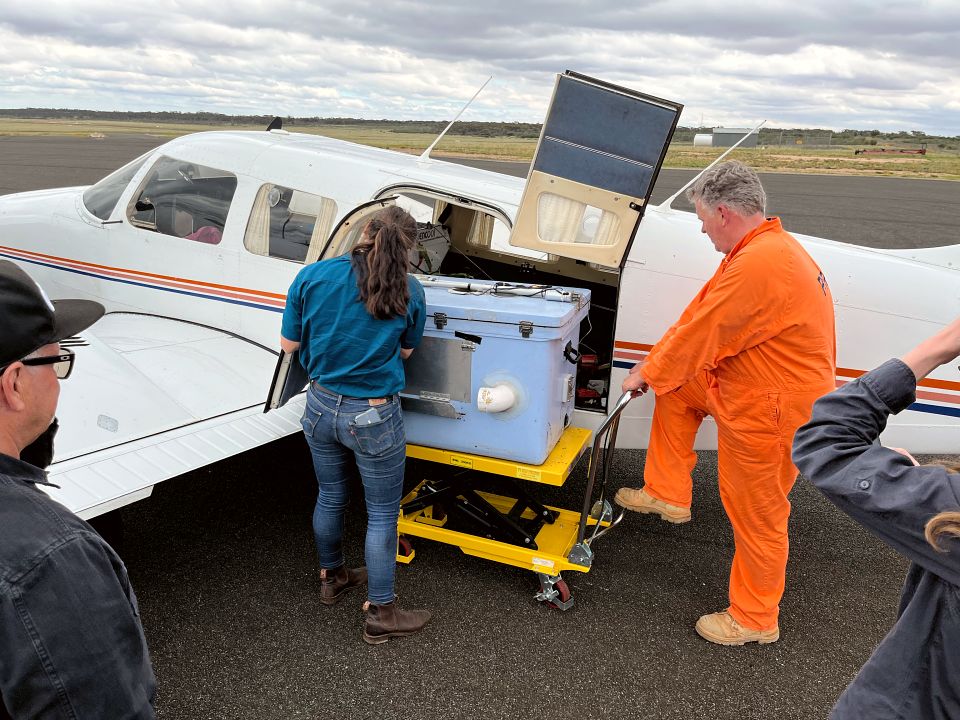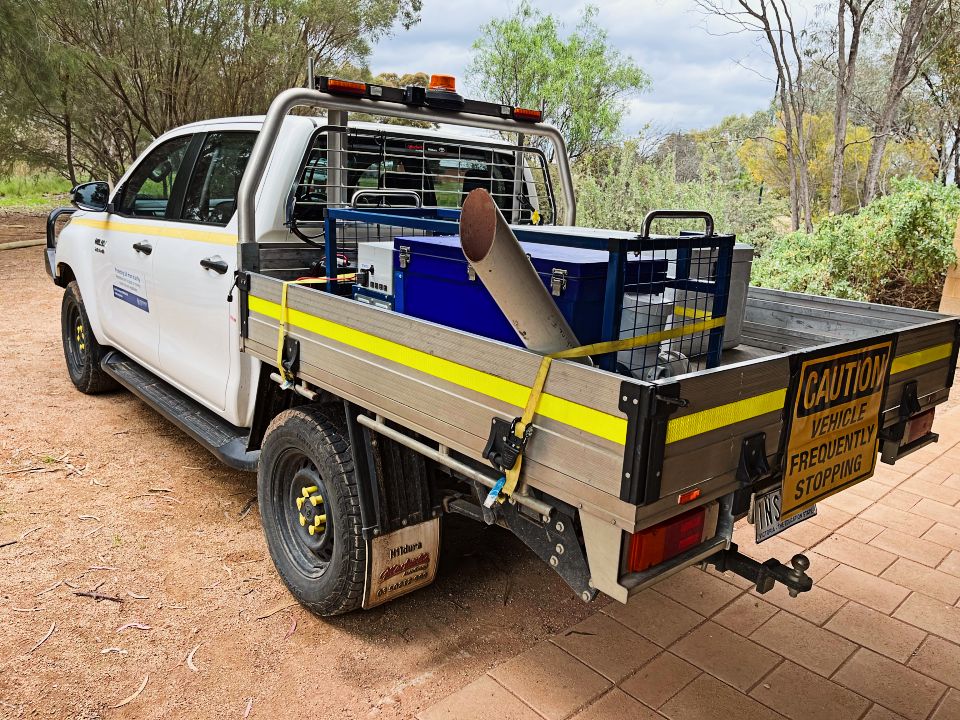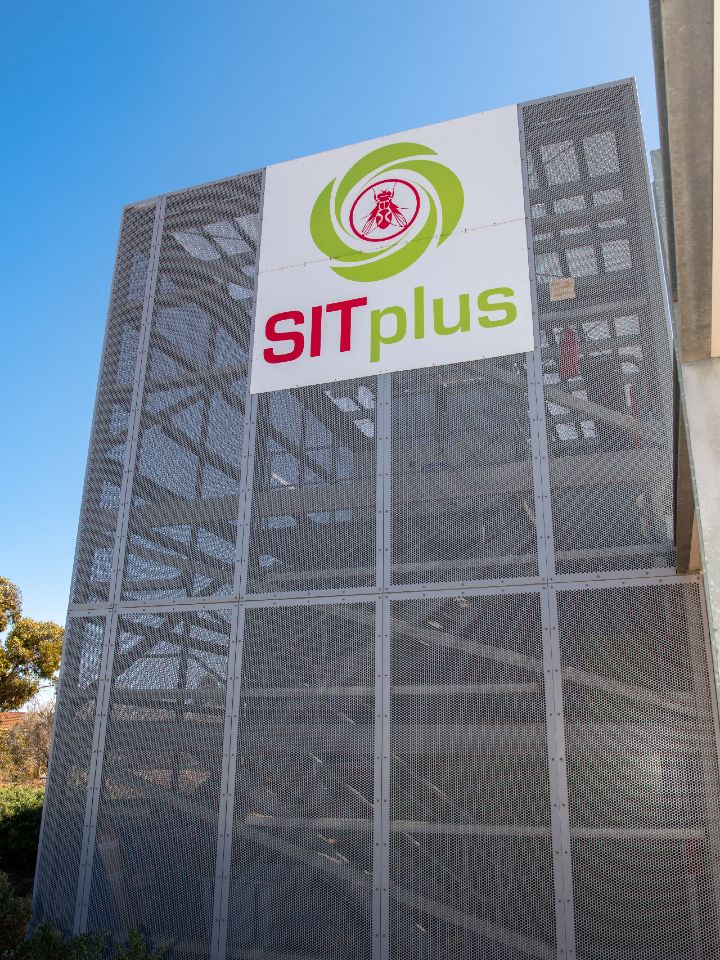Sterile insect technique (SIT)
Sterile insect technique (SIT) – introducing sterile insects to help control wild insect populations – is being used in the Riverland to reduce the wild Queensland fruit fly numbers.
SIT insects are transported to an outbreak area and released to interrupt the breeding cycle of the wild population.
In the past, managing Queensland fruit fly has relied heavily on insecticides. Sterile fruit flies are a more sustainable solution to helping control Queensland fruit fly nationally.
SIT flies will be released at Winkie, Glossop, Berri, Monash, Monash West, Cobdogla and Barmera from 1 April until 12 May 2024.
Find out more about the sterile fly release for Adelaide summer 2024.
How SIT works
Sterile fruit flies are released into an outbreak area. These sterile fruit flies then outnumber the wild fruit fly population and interrupt the breeding cycle. They reduce the chance of wild fruit flies being able to meet, breed and produce fertile young.
The SIT effect is similar to going to a football field to meet a friend: If you’re there and no one else is around, you’d probably find your friend pretty easily. But if you put thousands of people in that area – like a sterile fruit fly release – it's very unlikely you’d be able to meet up.
Transcript
Transcript
[Text] What is Sterile Insect Technology?
[Text] Nick Secomb General Manager Fruit Fly Response PIRSA
[Nick] So today we'd really like to talk to you about sterile insects and how they work. So sterile insect technology, also known as SIT, is the breeding of sterile insects to control wild populations. In this case we're talking about fruit fly. We've got a dedicated facility in Port Augusta where we breed those and take them to a place where we're having an outbreak response, where they're used to interrupt the breeding cycle of that wild population. By doing that, the wild population can't produce fertile young and the breeding cycle is broken. Once they're in their outbreak area, they're either released through an aeroplane or sometimes by a vehicle on the road. They're put into a special container in the back of a vehicle and then put out through a chute into the area where they need to be. In the case of an aeroplane, they're also put into a special cooled container, released from the plane and they float down into the orchard where they can do their job.
[Text] How does sterile insect technology work?
[Nick] So sterile insects work by interrupting the breeding cycle. They overwhelm any wild flies that might be still in the environment and stop them from breeding. And it's a bit like if you're going to the Adelaide Oval to meet a friend. If you were going there and there was no one else in the ground, if you walked around for 4 or 5 minutes, you'd probably find your friend really easily. But if you put a whole lot of people in that ground, which is just like sterile flies, you put 50 or 60,000 people in the way, it's very unlikely you'd be able to find your friend in the Adelade Oval. So they basically get in the way. They get in the way of those wild flies, and by being in the way, the wild flies can never meet each other, they can never mate, and so the breeding cycle is broken.
[Text] Why is it important to use other tools with sterile insect technology to eradicate a fruit fly outbreak?
[Nick] So it's really important to use other tools to lower any wild fly numbers in the area before sterile flies are released so they have every chance of doing their job. Tools like bait, and traps, and picking up fruit, and disposing of fruit properly, make sure we get that wild population down really low and then the sterile flies have the best chance of doing their job well. If you're a commercial grower or a residential person in and outbreak area, there's a few things you can do to help us with that. First of all, pick any fruit that's not being used and check it. Check that fruit for any blemishes. If there's anything on there that looks like a little bruise or that fruit flow may have stung it, cut the fruit open. If there's anything wriggling inside, please call our hotline on 1300 666 010 and we can check to see if it's fruit fly or not. Commercial growers should speak with PIRSA about fruit movement restrictions and what you need to do to make sure you can help with eradication.
Timing for SIT
SIT is effective for 'mopping up' after the wild fruit fly population has been reduced through targeted methods like bait, ground treatments and cover sprays. It isn't the single solution to an outbreak.
SIT is more successful when the wild fruit fly population numbers are low. This way, when SIT flies are released, they will easily outnumber the wild fruit fly population. Flies will actively search out other flies to mate with. This is how SIT flies make it very hard for wild fruit flies to find other wild fruit flies to mate and breed with.
South Australia has international protocols with national and international trading partners, which prohibit SIT flies being used after an outbreak has ended.
Breeding process
PIRSA's National SIT Facility in Port Augusta breeds and sterilises Queensland fruit flies. The facility has a series of rooms with different temperature and humidity controls to optimise breeding and growth.
-
1. Eggs are collected from adult cages, then laid into plastic tubes and collected by washing them into sieves.
-
2. The eggs are spread onto diet trays where they hatch into larvae.
-
3. The larvae (maggots) grow inside larval towers in the larval room for 6–7 days.
-
4. Larvae jump out of their trays after 6–7 days into water below and are harvested and put into bags with vermiculite.
-
5. The larvae turn into pupae in the bags over a couple of days.
-
6. After 6 days, the pupae are sieved in a mechanical sieving machine to remove the vermiculite again.
-
7. The next day, the pupae are dyed and packed into canisters.
-
8. Packed canisters sit overnight.
-
9. The following day, pupae are irradiated in an x-ray machine.
-
10. Pupae are sent via courier to the rear out centre.
-
11. At the rear out centre, the pupae are put into trays and supplied with food and water for 5 days to hatch and mature.
-
12. After 5 days the flies are cooled and packed into eskies to be delivered to the plane. Smaller containers of chilled flies are just tipped into the planes chilled release machine, and the lid closed before they warm up and wake up.
Recognising a sterile fruit fly
Sterile fruit flies are coated with a fluorescent dye before they leave the National SIT Facility. If you shine a blue light on a fly, the dye will glow.
This dye marker helps us identify fruit flies caught in outbreak areas as wild, or sterile. It helps us decide if we need to take action to fight wild fruit flies in the area where the fly was found.
Releasing sterile flies
SIT fruit flies are taken to the outbreak area, and either released using an aeroplane or a vehicle on the road.
- For an aerial release, the flies are put into a special cooled container, and released from the plane. The flies then float down to the area where they can do their job.
- For a road release, they are put into a special container on the back of a utility vehicle, and released through a chute.


Watch footage from an aerial SIT release on YouTube.
Trapped sterile fruit flies
A combination of both SIT fruit flies and wild fruit flies are caught in traps.
If we catch SIT flies in the outbreak area, we can compare the number of SIT flies trapped with the number of wild fruit flies. When we compare that with the numbers from previous wild fruit fly catches, we can see how the SIT population is impacting wild fruit fly populations.
SIT facility

The National SIT Facility in Port Augusta was designed to produce up to 20 million fruit flies per week when it first opened in November 2016.
In September 2023, the National SIT Facility expanded to double the production of sterile Queensland fruit flies to 40 million flies per week. The expansion included the addition of separate rooms for each stage of the fruit fly life cycle.
This was funded under the $30 million Australian Government National Building Resilience to Manage Fruit Fly package by PIRSA and by Citrus SA. Hon Geoff Brock MP opened the expansion on 6 September 2023.

